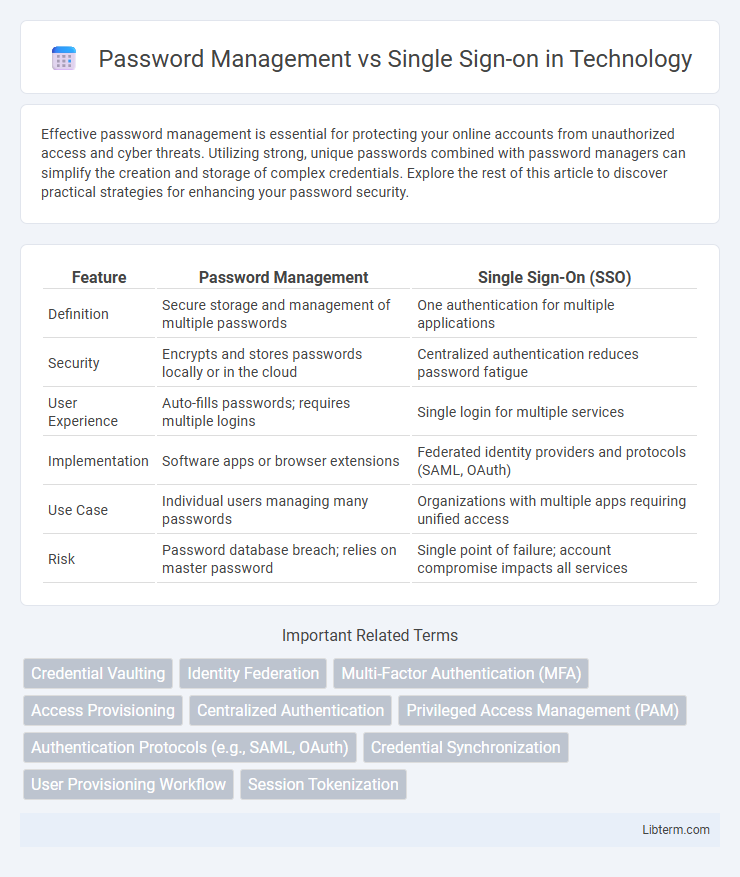Effective password management is essential for protecting your online accounts from unauthorized access and cyber threats. Utilizing strong, unique passwords combined with password managers can simplify the creation and storage of complex credentials. Explore the rest of this article to discover practical strategies for enhancing your password security.
Table of Comparison
| Feature | Password Management | Single Sign-On (SSO) |
|---|---|---|
| Definition | Secure storage and management of multiple passwords | One authentication for multiple applications |
| Security | Encrypts and stores passwords locally or in the cloud | Centralized authentication reduces password fatigue |
| User Experience | Auto-fills passwords; requires multiple logins | Single login for multiple services |
| Implementation | Software apps or browser extensions | Federated identity providers and protocols (SAML, OAuth) |
| Use Case | Individual users managing many passwords | Organizations with multiple apps requiring unified access |
| Risk | Password database breach; relies on master password | Single point of failure; account compromise impacts all services |
Introduction to Password Management and Single Sign-On
Password Management involves securely storing and organizing multiple passwords using dedicated tools like LastPass or 1Password to enhance password security and reduce the risk of breaches. Single Sign-On (SSO) allows users to access multiple applications and services with a single set of login credentials, streamlining access while minimizing password fatigue. Both technologies improve cybersecurity by addressing credential management challenges but differ in their approach to user authentication and convenience.
How Password Management Works
Password management tools store and encrypt user credentials securely, enabling automatic password entry and generation for various websites and applications. These solutions often support password vaults, multifactor authentication, and real-time breach detection to enhance security and usability. By centralizing access control, password managers reduce the risk of weak or reused passwords while maintaining user convenience.
Understanding Single Sign-On (SSO)
Single Sign-On (SSO) is an authentication process that allows users to access multiple applications with a single set of login credentials, significantly reducing password fatigue and improving security. Unlike traditional password management systems that require remembering or storing numerous passwords, SSO centralizes user authentication through a trusted identity provider, streamlining access control and enhancing user experience. Implementing SSO mitigates risks associated with weak or reused passwords by enforcing strong authentication methods across all connected services.
Security Advantages of Password Managers
Password managers enhance security by generating and storing complex, unique passwords for each account, significantly reducing the risk of password reuse and credential theft. They encrypt stored passwords using advanced algorithms, protecting sensitive data even if a device is compromised. Unlike single sign-on (SSO) systems, password managers eliminate the risk of a single point of failure by decentralizing access credentials across multiple accounts.
SSO Security: Benefits and Limitations
Single Sign-On (SSO) enhances security by reducing the number of passwords users need to remember, lowering the risk of password fatigue and reuse across multiple platforms. By centralizing authentication through trusted providers using protocols like SAML or OAuth 2.0, SSO enables stronger access controls and simplifies monitoring for suspicious activity. However, SSO's centralized nature creates a single point of failure, making robust multi-factor authentication and continuous security assessments essential to mitigate potential risks.
Usability: Comparing User Experience
Password management solutions streamline user experience by securely storing and autofilling multiple credentials, reducing the cognitive load of remembering numerous passwords. Single Sign-On (SSO) enhances usability by enabling access to multiple applications through a single authentication event, minimizing login prompts and session interruptions. Both methods improve user convenience, but SSO offers seamless access across integrated services, while password managers provide flexibility for non-integrated platforms.
Risk Factors: Password Managers vs SSO
Password managers reduce risk by generating and storing complex, unique passwords for each account, minimizing vulnerabilities from reused or weak passwords, but they become single points of failure if master passwords or vaults are compromised. Single Sign-on (SSO) systems simplify access by centralizing authentication, which can improve security through strong, centralized controls but also elevate risk, as a breach of SSO credentials potentially grants attackers access to multiple connected services. Both systems require robust multi-factor authentication and vigilant monitoring to mitigate unauthorized access and reduce overall cybersecurity risk.
Ideal Use Cases for Password Management
Password management systems excel in environments where users need to store and generate strong, unique passwords for multiple applications, enhancing security through encrypted vaults and automated password updates. Ideal use cases include organizations with diverse application ecosystems lacking centralized authentication, or individuals managing numerous personal accounts requiring robust credential protection. Password managers also support compliance with regulatory standards by ensuring password complexity and regular rotation without relying on a single authentication point.
When to Implement Single Sign-On
Single Sign-On (SSO) should be implemented when an organization requires streamlined access to multiple applications with enhanced security and improved user convenience. Enterprises with numerous cloud-based services and internal systems benefit most from SSO by reducing password fatigue and minimizing the risk of credential theft. Implementing SSO is ideal for organizations aiming to centralize authentication, enforce consistent access policies, and improve compliance with regulatory standards such as GDPR and HIPAA.
Choosing Between Password Management and SSO
Evaluating Password Management versus Single Sign-On (SSO) centers on security needs and user experience priorities. Password managers store encrypted credentials for multiple accounts, enhancing password complexity and reducing reuse risk, while SSO consolidates authentication under one credential, simplifying access across integrated platforms but increasing reliance on a single access point. Organizations must balance the comprehensive security controls of password managers against the streamlined access and administrative convenience provided by SSO solutions.
Password Management Infographic

 libterm.com
libterm.com